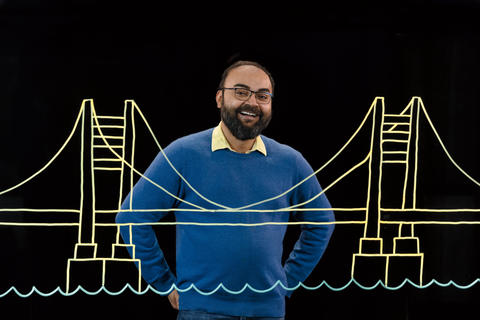
New bridges build connections for startups
Wednesday, May 4, 2022
After a period of pandemic slowdown, individuals in business are seeking new ways to connect with others.
That link could be–literally–walkways, according to a paper Carlson School of Management Assistant Professor Sunasir Dutta has co-written with engineers Daniel Erian Armanios of the University of Oxford and Jaison D. Desai of the U.S. Army’s Technical Warfare Center.
Their findings suggest constructing physical bridges over rivers or other obstacles can spur entrepreneurship, even ‘startups’ which are angel- and venture capital-funded. More importantly, bridges with provisions for pedestrians or cyclists can increase development in special ways.
“We found that multi-modal bridges really made a difference in terms of human connection and producing startups,” said Dutta. “Also, there’s much untapped potential in physical bridge building in the U.S. Connectivity is a worthy investment.”
Published in the journal Organization Science, Dutta and his colleagues analyzed bridge-related and other variables for more than 350 statistical areas in the U.S. from 1992-2012, and counted the number of angel- and VC-funded businesses founded in a year in those areas. They controlled for cities and states more likely to make infrastructure improvements, years with increased infrastructure activity, and partialed out the emergence of predictable businesses—such as construction contractors.
While mainly a panel-data (multi-year) study across 350+ areas in the US, the team also looked at two qualitative examples, the Ohio River Bridges Project connecting Louisville, Kentucky—via several bridges—to various communities; and San Diego’s Harbor Drive Pedestrian Bridge between the city’s downtown and harbor front.
The bridges in both cases were a source of connection that led to higher rates of businesses being founded throughout the city and even in close proximity to the water crossing, Dutta said. “For us that was about how physical connectivity which is typically taken for granted, really made things happen.”
Dutta and his colleagues found that new bridges increase startup founding, the rate of founders entering entrepreneurship—and resulting businesses increased the number of early-stage investors. More significantly, they learned that resulting ventures are more likely to span a broader range of industry categories.
However, in follow-on work, Dutta observed there’s room for considering equity in all bridge projects.
“Places that lack civic engagement or a say in the policy process often get bridges they don’t want,” said Dutta. “Bridges are especially a positive force if communities affected by them are consulted, and the bridges allow them to get across and connect with others—not just have neighborhoods and communities split by structures cutting across them.”
For Dutta, the impact of multi-modal bridges stands out. Since the San Diego Harbor Bridge’s construction in 2011 until July 2020, a daily average of 6,959 individuals on foot or bicycle crossed the bridge—the highest daily average of any bridge in the city. This produces “greater connectivity and the potential for serendipitous interactions” as individuals walk or bike across, Dutta said.
“We were surprised how much more effective bridges with a pedestrian side are,” Dutta said. “For one thing, more people get across each day if they have the ability to walk or bike. Walkways are basically an unheralded means of mixing people and innovation.”
